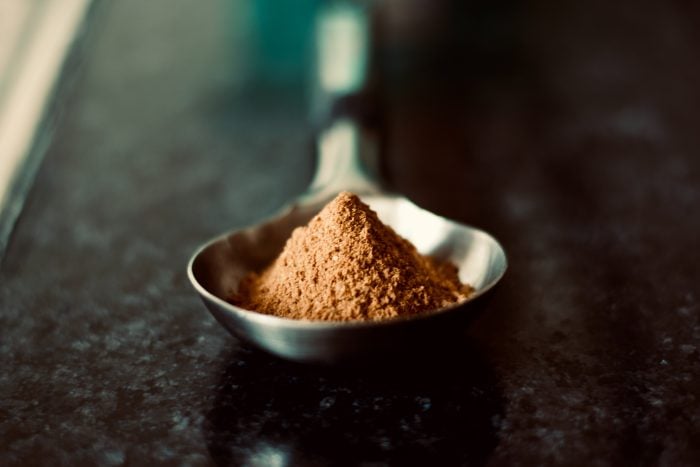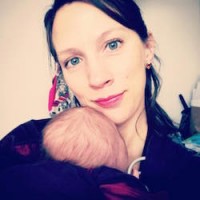Why, oh why, would anyone want to use dry shampoo, you ask?
Well, for me, it all began when I had platinum blonde hair and didn’t want to dry it out any more by washing it every day…so I didn’t…but that’s kind of gross—and that’s where my affinity for dry shampoo came in.
I’ve tried several brands in all different price ranges over the years and, ultimately, I genuinely prefer making my own.
For one, it saves on non-recyclable packaging, because you can repeatedly use your own containers and, for another, in my experience, many of the over-the-counter dry shampoos will cost you more than they’re worth and they’ll leave you smelling like bathroom spray (which, I don’t think is a great smell to have this close to your nose—especially considering that I tend to use dry shampoo when I’m going to the yoga studio pre-shower).
Now, why, you might also ask, does dry shampoo work?
Simple: the ingredients absorb the oils in your hair and leave you feeling and looking fresh rather than greasy, and the scent masks last night’s garlic-cooking, kitchen-dancing adventure—and making your own dry shampoo is free, cheap and you can scent it however you like (so you don’t run around smelling like bathroom potpourri).
I’m going to share two recipes with you and I’m going to be honest here: I have yet to make a dry shampoo recipe at home that I haven’t liked. The sprays from the store on the other hand? I dislike most of them.
Point: play around, have some fun and don’t be anal retentive about your measurements, because you’re guaranteed to like what you make. (I hope.)
Still, there is the fact that I’m currently a brunette, and not a platinum blonde who can put white powder in my hair without issue.
My twin sister, for example, said that she’s never liked dry shampoos because she feels that they leave her hair with a whitish-kind of look—which, frankly, no one wants. Personally, I’ve found that if you rub your scalp well with your fingertips and brush your hair a few times after application, that this doesn’t happen, but, none the less, I’m going to include a special recipe for you other dark beauties out there who have been scarred by dry shampoo usage in your past.
Okay, here goes:
Dry shampoo for light hair (or really any type):
- 1/4 cornstarch
- 2 Tbsp. baking soda
- 2 Tbsp. flour (any kind, even oat), optional
- 5-8 drops essential oil such as tea tree, optional (more for scent than anything else)
Mix all ingredients together and store in container of your choice.
Application: I’ve read sooooo many posts on using an old makeup brush and, while I’m sure this works great, I’m either lazy or, you know, in a hurry—hence using dry shampoo—and, instead, I simply dust my hands with the powder mixture and rub it on the roots of my hair. Focus mainly on getting your part-line and around the sides of your face and temples, where it tends to get the most oily. Use the warmth from your hands to blend it in and then brush your hair several times.
Dry shampoo for dark hair:
Basically you’ll be substituting cocoa powder for much of the cornstarch. Here’s what I find works best after trial and error:
- 1/4 cup cocoa powder
- 2 Tbsp. cornstarch
- 2 Tbsp. baking soda
- 5-8 drops essential oil, optional
- 2 Tbsp. flour, optional
Follow the same directions for mixture, storing and applying as aforementioned recipe.
I’ve also used simple baby powder, as well as straight-up cornstarch, and both work well in a pinch.
If you use too much of the baking soda, the texture might feel a little gritty. Generally speaking, the secret is to not over-apply. Use a little, tiny bit and keep in mind that you can always add more.
I hope this helps you other busy mamas out there who still want to look gorgeous dropping your kids off at school before you dash off for your morning exercise or for the other working mamas who occasionally don’t have the ideal and necessary amount of prep time for themselves.
If you have favorite recipes or tweaks that you love, please leave them for other readers in the comment section below.
Enjoy!
Ready to join?
Hey, thanks so much for reading! Elephant offers 1 article every month for free.
If you want more, grab a subscription for unlimited reads for $5/year (normally, it's $108/year, and the discount ends soon).
And clearly you appreciate mindfulness with a sense of humor and integrity! Why not join the Elephant community, become an Elephriend?
Your investment will help Elephant Journal invest in our editors and writers who promote your values to create the change you want to see in your world!
Already have an account? Log in.
Ready to join?
Hey, thanks so much for reading! Elephant offers 1 article every month for free.
If you want more, grab a subscription for unlimited reads for $5/year (normally, it's $108/year, and the discount ends soon).
And clearly you appreciate mindfulness with a sense of humor and integrity! Why not join the Elephant community, become an Elephriend?
Your investment will help Elephant Journal invest in our editors and writers who promote your values to create the change you want to see in your world!
Already have an account? Log in.
 Share on bsky
Share on bsky






Read 12 comments and reply